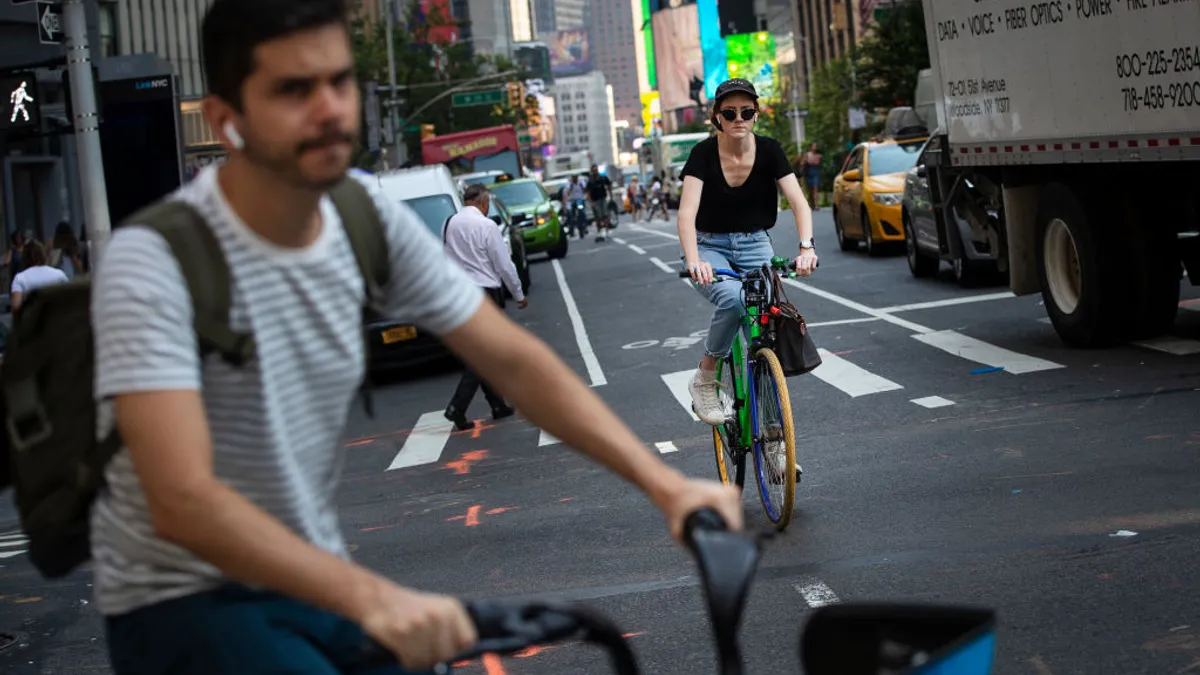Dive Brief:
- Urban planning that incorporates widespread electrification and carbon-sequestration while making cities denser is the best way cities can slash emissions within the next decade to limit global warming, according to authors of the highly anticipated United Nations climate change mitigation report released Monday.
- The report, the third release from the Intergovernmental Panel on Climate Change's Sixth Assessment Report, addresses buildings, transportation, and energy systems, as well as entire urban systems.
- Some of the authors said the report ought to gravely reinforce to leaders the importance of making changes immediately, even though the information and strategies it contains largely are not new and the IPCC isn't meant to be a prescriptive body.
Dive Insight:
Global greenhouse gas emissions must stop rising by 2025 to limit warming to the 1.5 degrees Celsius threshold, the target of the Paris Agreement, according to scientists. It's long been known that urban centers play an important role in mitigating climate change. The IPCC counts at least 826 cities that have adopted zero-emissions targets, but everyone must get more aggressive in implementing such strategies to more rapidly slash emissions, UN leaders and report authors say.
"It is not a pretty picture," said United Nations Environment Programme Executive Director Inger Andersen in a press conference Monday, noting that the last two decades saw the highest increase in emissions in human history. "Half measures will not halve greenhouse gas emissions by 2030, which is what we need to do. And we all need to go in on this. The IPCC tells us that we have the knowledge and the technology to get this done."
Even with the more solutions-oriented nature of this latest report, the IPCC's charge is not to tell governments exactly how to act to lower emissions. The organization does, however, lay out many important options. Regarding energy systems, for example, the report broadly calls for widespread electrification and improved energy efficiency while acknowledging that electric energy must itself come from renewable sources.
According to Paulina Jaramillo, a professor of engineering and public policy at Carnegie Mellon University and an author of the transportation-focused chapter of the report: "It's not like there's some novel solution that no one had thought about 15 years ago."
"Unfortunately, there's nothing completely new that no one saw coming. It's just we really need to start implementing these things," Jaramillo said. Solutions to cut transportation emissions, according to the report, include electrified and more accessible public transport systems; electrification of private vehicles and expansion of charging infrastructure; urban environments designed to reduce distances that must be traveled; and a society that supports more active transport like walking and cycling.
On the upside, some of these known solutions have gotten cheaper, better or easier to implement, Jaramillo said. And cities still have room to incentivize change through different pricing mechanisms, be it congestion pricing or ensuring that public transport options cost less, she said.
City approaches to reducing emissions will depend on whether it’s a new or rapidly growing city, or a more established city, said Karen Seto, a professor of geography and urbanization science at the Yale School of the Environment, who co-led the section of the report on urban mitigation. Regardless, one of the most achievable and impactful strategies is strategic infilling, or increasing population density so that people are less reliant on motorized transportation to get to where they work, for instance, she said.
As for environmental design that promotes carbon sequestration, "green and blue" infrastructures like urban forests or wetlands are tried-and-true strategies, but buildings also present an increasingly important opportunity. Buildings that are made from biomass-based structural materials instead of emissions-intensive steel and concrete are "a massive opportunity for urban infrastructure,” Seto said.











